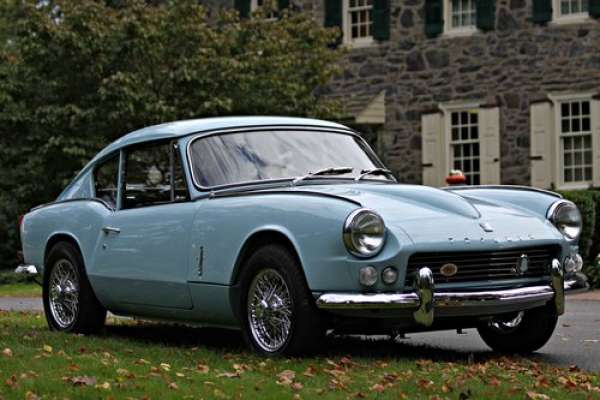The GT6 owes its heritage to the four 1964 Le Mans Spitfires. These Spitfires were very successful competition cars aimed at winning their class and giving a bit of stick to MG! Producing 102 BHP at 7,000 RPM, these remarkable cars conquered the 24 hour race reaching top speeds of 134 MPH. David Hobbs and Rob Slotemaker bought in ADU2B in 21st Place overall and 3rd in class averaging 94.7MPH for the whole 24 hours. Unfortunately ADU1B and ADU3B retired after being involved in accidents and not because of mechanical problems and after having been leading their class. ADU 4B didn’t race but was kept as a spare.
Spurred on by success, Harry Webster commissioned Michelotti to pen a Spitfire GT. Webster sent Michelotti a prototype based on the Le Mans Spitfire and Michelotti waved his magic wand and the returned vehicle looked more or less exactly how it came off the production line. This was becoming a very familiar Michelotti trait as time and again, he designed cars that went straight into production without factory modification.
The first prototype was found wanting in power as the 1,147cc engine of the Spitfire couldn’t perform with the extra weight of the fast back, bigger engine and trim. A Vitesse 1,600cc motor was tried but as the Vitesse engine was being upgraded to 2,000cc it was decided to use this motor instead. The major engineering difficulties were in fitting the engine into the bay. This was overcome by moving the radiator forward and introducing a huge power bulge down the centre of the bonnet. Immediately the car became dubbed the “poor man’s E Type” or the “mini E Type” as it produced real power and performance.
According to Autocar, the car had a maximum speed of 106MPH and produced 95BHP at 5,000RPM. Compression ratio was 9.5:1 and could accelerate to 60MPH in 12.0 seconds. In 1966, these statistics were quite good. Transmission was a four speed fully synchromesh box and most had the optional overdrive on 2nd, 3rd and top.
The only drawback was that Triumph didn’t do anything about the rear suspension which continued to use the swing axles of the Spitfire. With all the extra power, the car could be quite nasty in the hands of an inexperienced driver. As a result the motoring press had a “field day” criticising the car’s handling.
The car was built between 1966 and 1968 with production reaching 15,818 units. The author owned one of these cars which was purchased new. The performance seemed to be much better than the quoted Autocar results and the appointments were luxurious for the day. The dash was walnut with extensive instrumentation and great seats which gave genuine support. My car had optional wire wheels which looked particularly great and enhanced the car’s style even further.
GT6 MK1
|
Engine
|
Pushrod OHV 6 cylinder
|
|
Capacity
|
1998 cc
|
|
Compression
|
9.5:1
|
|
Power
|
95 BHP @ 5000 RPM (?Kw)
|
|
Torque
|
117 lb-ft @ 3000 RPM
|
|
Aspiration
|
Twin Carb
|
|
Gearbox
|
4 speed manual with overdive on 3rd and 4th.gears
.
|
|
Diff Ratio
|
3.45:1 (manual)
|
|
Suspension
|
Front: Coil Springs / Wishbone / Anit Roll Bar / Rack and Pinion steering
Rear : Transverse Leaf Spring / Wishbone
|
|
Brakes
|
Front 9 3/4 inch Disc
Rear 8 x 1 1/4 inch Drum
|
|
Performance
|
0-60 11.1 seconds
Max Speed 107 MPH
|

